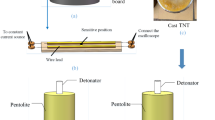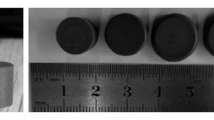Abstract
To tackle challenges of man-machine contact, manual operation, and low degree of mechanical automation in the charging process of traditional polymer bonded explosive (PBX), we adopted a vertical extrusion charging process to realize continuous extrusion charging of the slurry into missiles. In this work, the screw structures were optimized via simulation software after slurry physical property analysis, as well as the influence of the parameters including speed and temperature on the process was further explored. The results indicated that, compared with the pineapple head structure featuring a high shear function, the conventional three-piece screw structure maintains the moderate fluctuation in viscous heating of the slurry, which is suitable for stable and safe delivery of high-sensitivity slurries. Meanwhile, an appropriate outlet size φ and barrel cone angle θ contributes to pressure distribution manipulation in the flow path, and a relatively high output was obtained at 30 mm and 1°, respectively. Additionally, the adjustment of process parameters such as speed and temperature is conducive to reducing occurrence probability of local hot spots and restraining deformation of screw blade structures, the balance between output and process hazard was achieved.














Similar content being viewed by others
Data availability
The data that support the findings of this study are available on request from the corresponding author, Wang, upon reasonable request.
References
Lin CM, Gong FY, Qian W, Huang XN, Tu XQ, Sun GA, Bai LF, Wen YS, Yang ZJ, Guo SY (2021) Tunable interfacial interaction intensity: Construction of a bio-inspired interface between polydopamine and energetic crystals. Compos Sci Technol 28
Deng C, Liu HH, Cui YT, Zhu XN, Bai YP, Hu Z (2023) Low-temperature preparation of novel fluoro-fluoro semi-interpenetrating polymer networks as a strong, tough and safe polymer binder for PBX. Polymer 264
Wang S, Xiao L, Hu Y, Zhang G, Gao H, Zhao F, Hao G, Jiang W (2021) A review on the preparation and application of nano-energetic materials. Chin J Explos Propell 44:705-734. https://doi.org/10.14077/j.issn.1007-7812.202112013
Wang XF (2022) Some opinions about insensitive munitions. Chin J Explos Propell 45:285-289. https://doi.org/10.14077/j.issn.1007-7812.202112003
Deng H, Li G, Guo HW, Liang ZF (2022) Development status and trend of insensitive ammunition technology. J Ord Eq Eng 43:137-144. https://doi.org/10.11809/bqzbgcxb2022.02.021
Xiao YC, Gong TY, Zhang XW, Sun Y (2023) Multiscale modeling for dynamic compressive behavior of polymer bonded explosives. Int J Mech Sci 242
Stephen SJ, Anderson EK, Short M, Chiquete C, Jackson SI (2022) Effect of lot microstructure variations on detonation performance of the triaminotrinitrobenzene (TATB)-based insensitive high explosive PBX 9502. Combust Flame 246
Zhang MM, Luo YM, Wang HX, Jiang QL, Yang F (2021) Study on technological difference between polymer based explosive and traditional melt-cast carrier explosive. Explos Mater 50:29–34. https://doi.org/10.3969/j.issn.1001-8352.2021.03.006
Yan QL, Nie DF, Yang ZJ (2020) Polymer bonded explosives and their properties. National Defense Industry Press, Bei Jing, pp 1–80
Zong HZ, Cong QL, Zhang TY, Hao YJ, Xiao L, Hao GZ, Zhang GP, Guo H, Hu YB, Jiang W (2022) Simulation of printer nozzle for 3D printing TNT/HMX based melt-cast explosive. Int J Adv Manuf Tech 119:3105–3117. https://doi.org/10.1007/S00170-021-08593-Z
Jiang HL, Wang XF, Chen S, Chen J, Feng B (2014) Development and application of explosive mixing technology. Aerosp Technol 441:78-82. https://doi.org/10.16338/j.issn.1009-1319.2014.12.001
Wang CG, Wei M, Liu XG, Liu YF (2013) Charging technology application of high power insensitive melt-pour explosive based on DNAN. Ord Ind Autom 32:45–51. https://doi.org/10.7690/bgzdh.2013.01.013
Jin DY, Wang QH, Niu GT, Wang HX, Niu L, Cao ST (2015) Analysis of process safety on casting a DNAN based melt-cast explosive. Science Technol Eng 15:176–181. https://doi.org/10.3969/j.issn.1671-1815.2015.08.034
Ma XQ, Jin L, Zhang YJ, Dong LQ, Xin F, Li XW (2018) Application status and development of continuous extrusion technology for energetic materials. Plastics 47:8–11. https://navi.cnki.net/knavi/journals/SULA/detail?uniplatform=NZKPT
Wang SW, Song XD, Wu ZK, Xiao L, Zhang GP, Hu YB, Hao GZ, Jiang W, Zhao FQ (2021) Simulation of the plasticizing behavior of composite modified double-base (CMDB) propellant in grooved calendar based on adaptive grid technology. Def Technol 17:1954–1966. https://doi.org/10.1016/j.dt.2021.05.008
Zhou K, He ZQ, Yin SP, Chen WH (2014) Numerical simulation for exploring the effect of viscosity on single-screw extrusion process of propellant. Procedia Eng 84:933–939. https://doi.org/10.1016/j.proeng.2014.10.518
Li XZ, Xue P, Song XD, Wang JN (2021) Research progress in numerical simulation of energetic material processing China. Plast Ind 49(1–6):12. https://doi.org/10.3969/j.issn.1005-5770.2021.01.001
Junwei ZH, Liqun DO, Yun MA, Jun ZH, Ping XU (2021b) Study on safe mixing radial clearance of conical twin-screw for extrusion of energetic materials. China Plast 35:125-132. https://doi.org/10.19491/j.issn.1001-9278.2021.11.019
Prickett S, Thomas WG, Radack CM, Kalyon DM, Malik M, Kowalczyk JE (2005) Twin screw extrusion processing of double base propellant. AICE, CINTI, USA. https://aiche.confex.com/aiche/2005/techprogram/P29070.HTM
Zhong TT (2015) Numerical simulation research of rheological behavior for the screw extrusion molding process of double-base propellant. NUST, China pp 1-70. https://kns.cnki.net/kcms2/article/abstract?v=3uoqIhG8C475KOm_zrgu4lQARvep2SAk6nr4r5tSd_pTaPGgq4znCc0anlokiy12_ve5ZBvA4Hs80RpJrFX6VZKXpC4teN-&uniplatform=NZKPT
Peng ZY, Xue P, Song XD, Zhang J, Jia MY (2020) Effect of solid content on calendered plasticizing properties of solid propellants substitute materials. J Solid Rocket Technol 43:302–309. https://kns.cnki.net/kcms2/article/abstract?v=3uoqIhG8C44YLTlOAiTRKibYlV5Vjs7i8oRR1PAr7RxjuAJk4dHXopUb_vY1U5y3_fvuqBQBdiPCAZiOTa1wZTAaaAu5R3_&uniplatform=NZKPT
Li M (2020) Simulation research the single-screw extrusion process of energetic materials. BUCT, China pp 1-105. https://doi.org/10.26939/d.cnki.gbhgu.2020.000857
Shen XL (2021) Simulation of propellant screw extrusion process and optimization of screw extrusion component structure. NUST, China pp 1-80. https://doi.org/10.27241/d.cnki.gnjgu.2021.001589
Karwe MV, Jaluria Y (1990) Numerical simulation of fluid flow and heat transfer in a single-screw extruder for non-Newtonian fluids. Numer Heat Tra-Appl 17:167–190. https://doi.org/10.1080/10407789008944738
Chinesta F, Gilles A (2015) Rheology of non-spherical particle suspensions. Elsevier Ltd, Netherlands, pp 22–96
Wright PG (1997) The variation of viscosity with temperature. Phys Educ 12:323–325. https://doi.org/10.1088/0031-9120/12/5/012
Yang KX (1998) Study on characteristics of flow viscosity of HTPB prepolymer. J Propul Technol 19:104–106. https://doi.org/10.3321/j.issn:1001-4055.1998.05.021
Chen MH, Huang WJ, Zhang YY, Sun YZ (2022) Study on mechanism function and thermal safety of a four component HTPB propellant. J Ord Eq Eng 43:61-66. https://doi.org/10.11809/bqzbgcxb2022.04.011
Dombe G, Mehilal C, Bhongale PP, Singh B (2015) Bhattacharya, Application of twin screw extrusion for continuous processing of energetic materials. Cent Eur J Energ Mat 12:507–522. https://www.researchgate.net/publication/283128927_Application_of_Twin_Screw_Extrusion_for_Continuous_Processing_of_Energetic_Materials
Cong HY, Yang F, Lin GY, Lu VY, Ceng FD (2002) Study on extrusion properties of low shearing screw, China. Rubber/Plast Technol Eq 28:1-4. https://doi.org/10.13520/j.cnki.rpte.2002.11.001
Li M, Xue P, Wang JN, Song XD, Zhang J (2020) Simulation analysis for single screw extrusion process of typical energetic material. J Solid Rocket Technol 43:594–601. https://doi.org/10.7673/j.issn.1006-2793.2020.05.008
Li RE, Haiqing BA, Jun BA, Shikui JI, Wang QI, Yiwei AN (2021) Structural design and simulation analysis of screw extrusion 3D printer. China Plast 35:98-105. https://doi.org/10.19491/j.issn.1001-9278.2021.04.017
Ruan J (2020) Rheological property and mechanical property of energetic material substitute in extrusion process. NUST, China pp 1-48. https://doi.org/10.27241/d.cnki.gnjgu.2020.000357
Chang Y (2022) Research on visualization of twin-screw extrusion and plasticizing quality of energetic material simulants. BUCT, China pp 1-86. https://doi.org/10.26939/d.cnki.gbhgu.2022.001338
Wang L, Zhao ZC, Cai Q (2020) Study on influence of flood on load of natural gas pipeline crossing river, Oil-Gas. Field Surf Eng 39:47-52, 72. https://doi.org/10.3969/j.issn.1006-6896.2020.05.010
Wu JR, Li HZ, Yang Y, Zhang XW, Qiao YQ (2022) Coupling analysis of mechanical stress and thermal stress of printed circuit heat exchanger core in supercritical carbon dioxide power cycle. Proc CSEE 42:640-650. https://doi.org/10.13334/j.0258-8013.pcsee.210267
Tessier MJ, Floros MC, Bouzidi L, Narine SS (2016) Exergy analysis of an adiabatic compressed air energy storage system using a cascade of phase change materials. Energy 106:528–534. https://doi.org/10.1016/j.energy.2016.03.042
Budt M, Wolf D, Span R, Yan JY (2016) A review on compressed air energy storage: Basic principles, past milestones and recent developments. Appl Energ 170:250–268. https://doi.org/10.1016/j.apenergy.2016.02.108
Song YL (2022) Study on coating desensitization of typical energetic materials based on interface enhancement. SUST, China pp 1-72. https://doi.org/10.27415/d.cnki.gxngc.2022.000595
Bian L, Qiao XL, Li JJ, Hou Y, Guo Q (2020) New method for characterizing flow property of solid propellant slurry during casting. J. Solid. Rocket. Technol. 43:506–510. https://doi.org/10.7673/j.issn.1006-2793.2020.04.013
Acknowledgements
This work was financially supported by the National Natural Science Foundation of China (No. 12102194, 22105103 and 22005144), the Natural Science Foundation of Jiangsu Province (BK20200471), and China Postdoctoral Science Foundation (No. 2020M673527 and 2021M691580).
Author information
Authors and Affiliations
Corresponding authors
Ethics declarations
Conflict of interest
The authors declare that they have no known competing financial interests or personal relationships that could have appeared to influence the work reported in this paper.
Additional information
Publisher's Note
Springer Nature remains neutral with regard to jurisdictional claims in published maps and institutional affiliations.
Rights and permissions
Springer Nature or its licensor (e.g. a society or other partner) holds exclusive rights to this article under a publishing agreement with the author(s) or other rightsholder(s); author self-archiving of the accepted manuscript version of this article is solely governed by the terms of such publishing agreement and applicable law.
About this article
Cite this article
Lin, GM., Wang, SW., Xiao, L. et al. Study on the mechanical and thermal parameters of PBX during the vertical extrusion charging process. J Polym Res 30, 225 (2023). https://doi.org/10.1007/s10965-023-03612-x
Received:
Accepted:
Published:
DOI: https://doi.org/10.1007/s10965-023-03612-x




